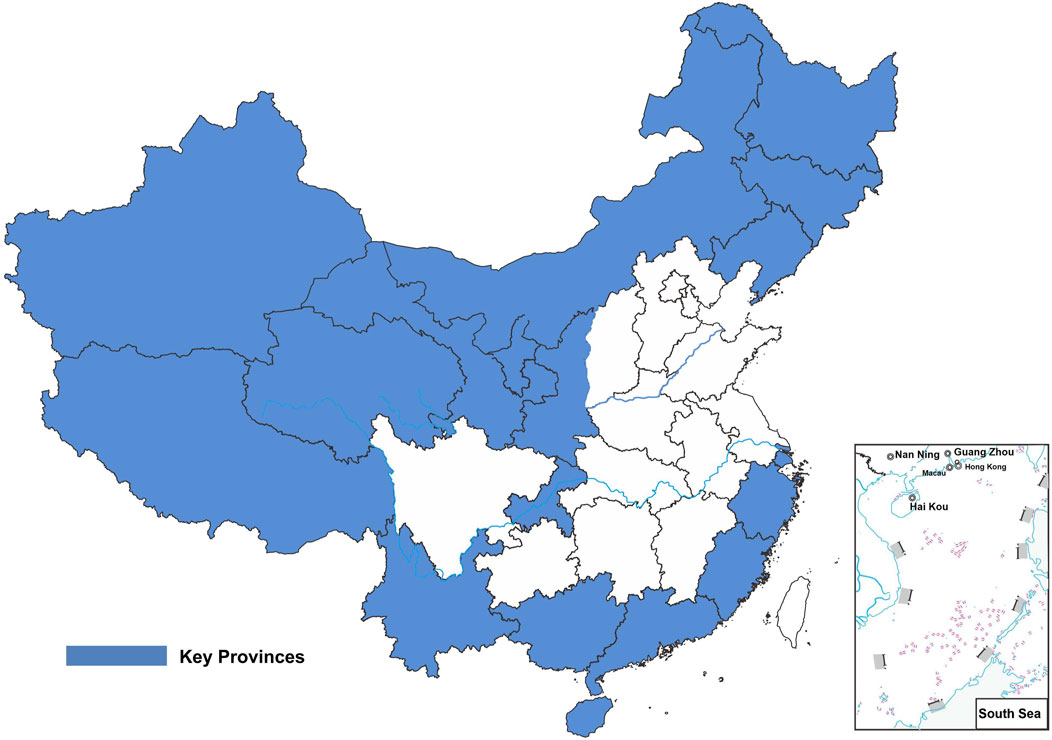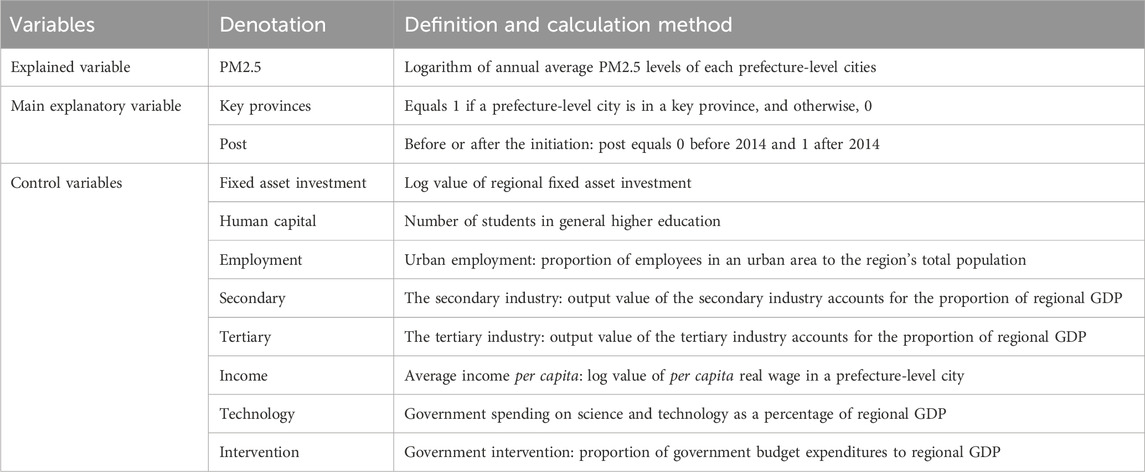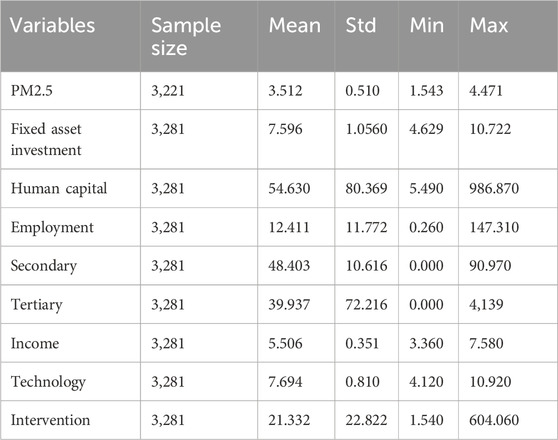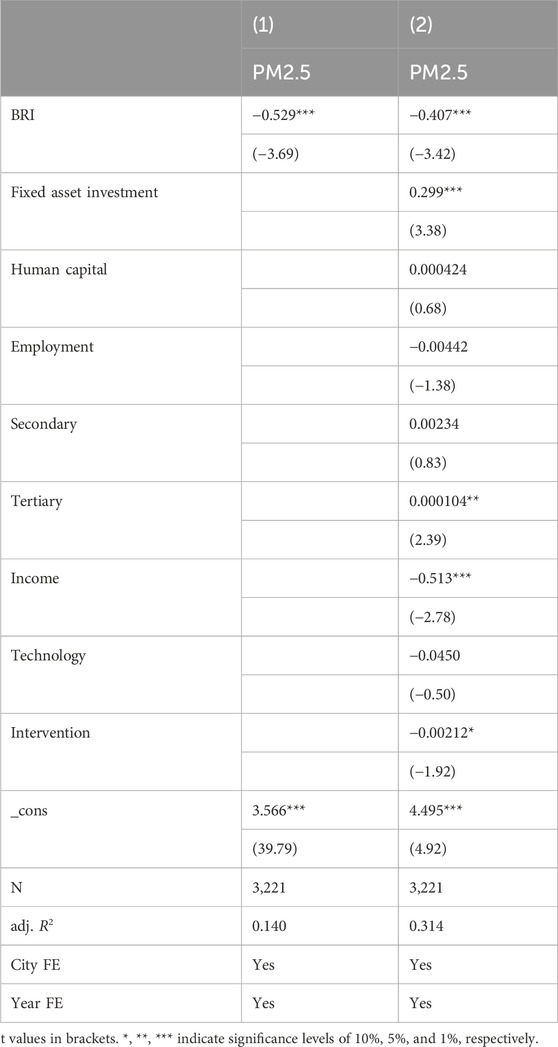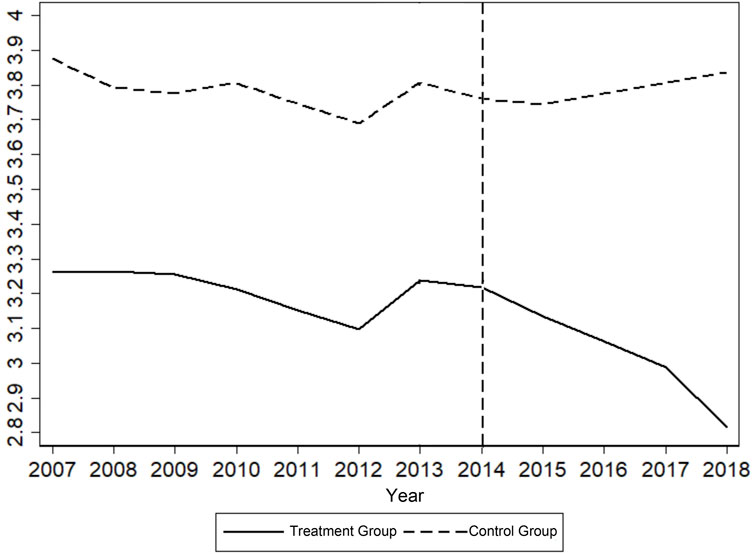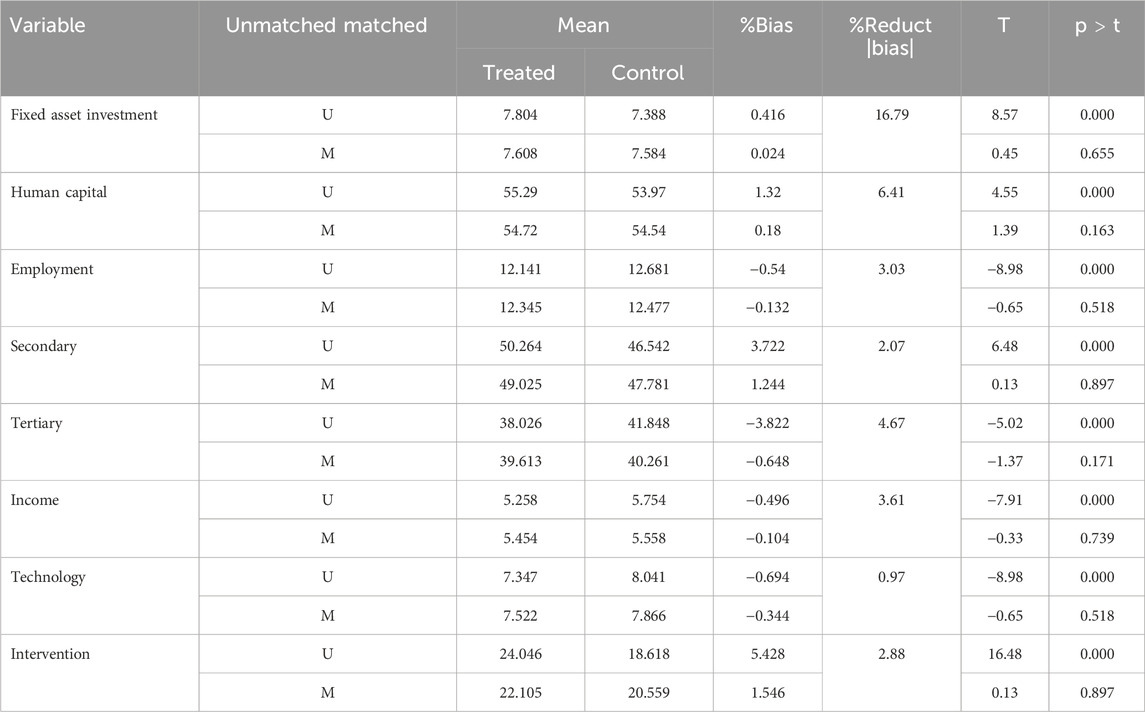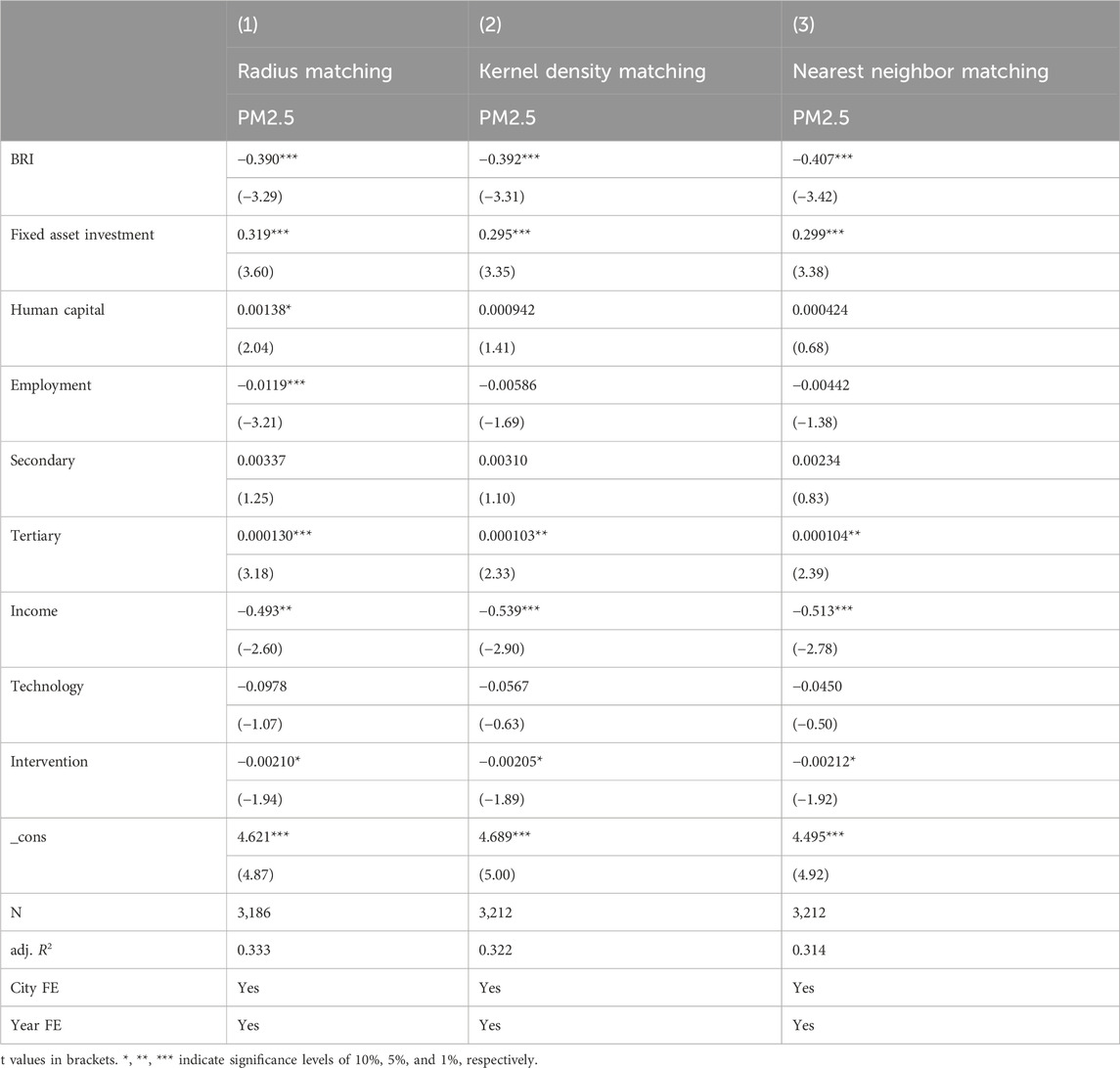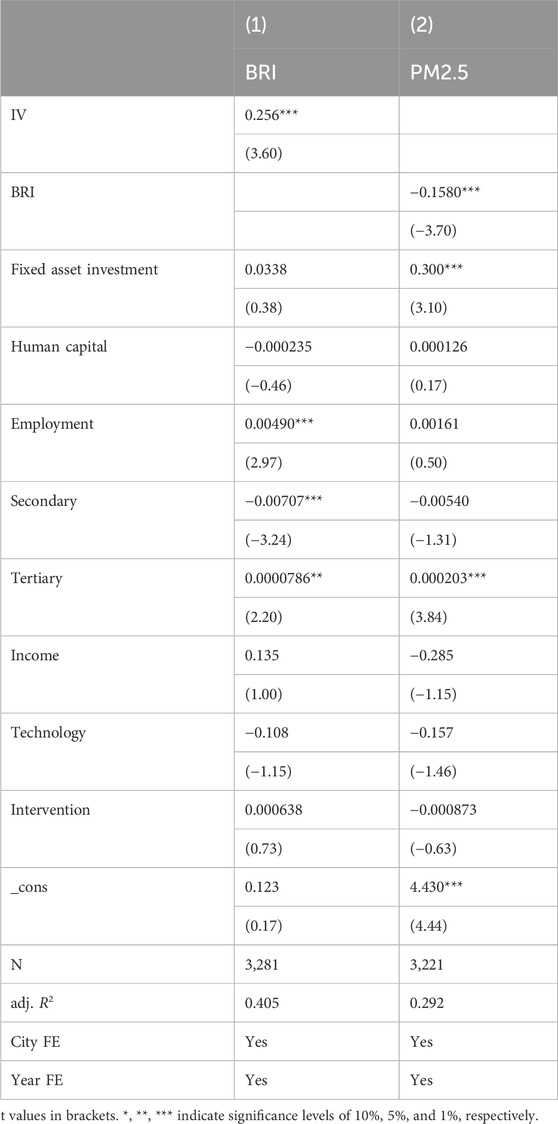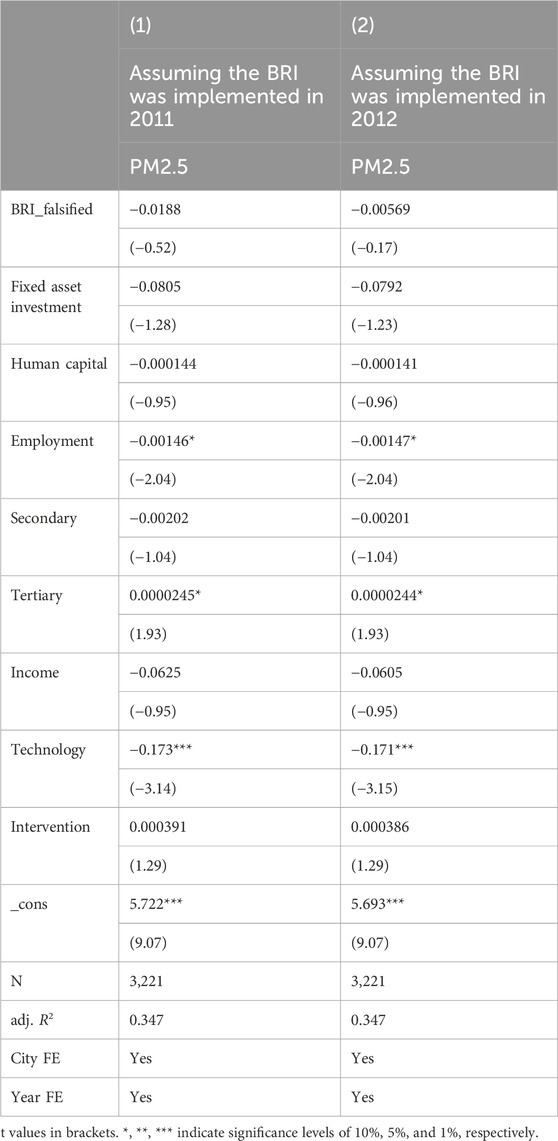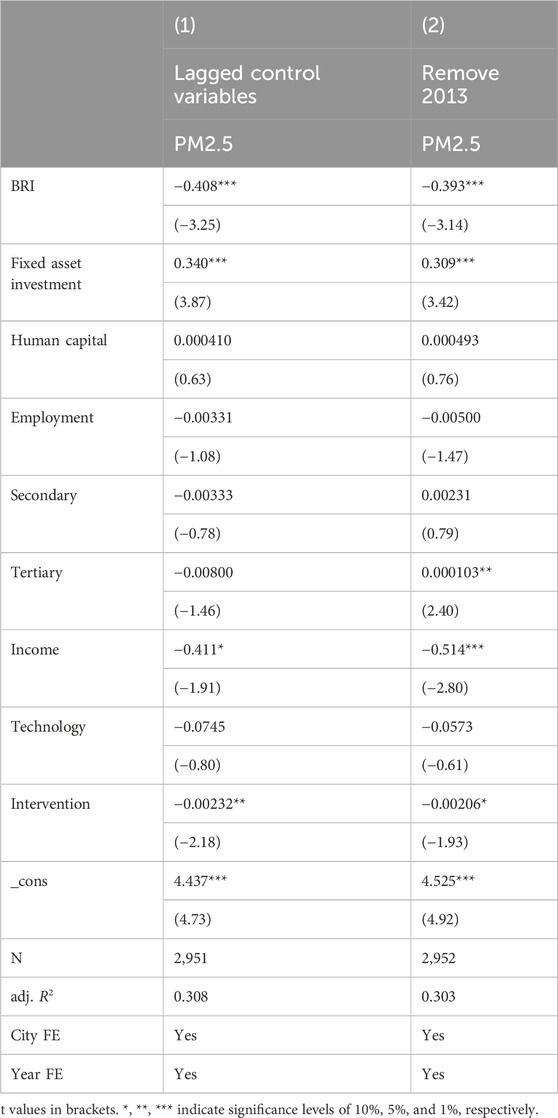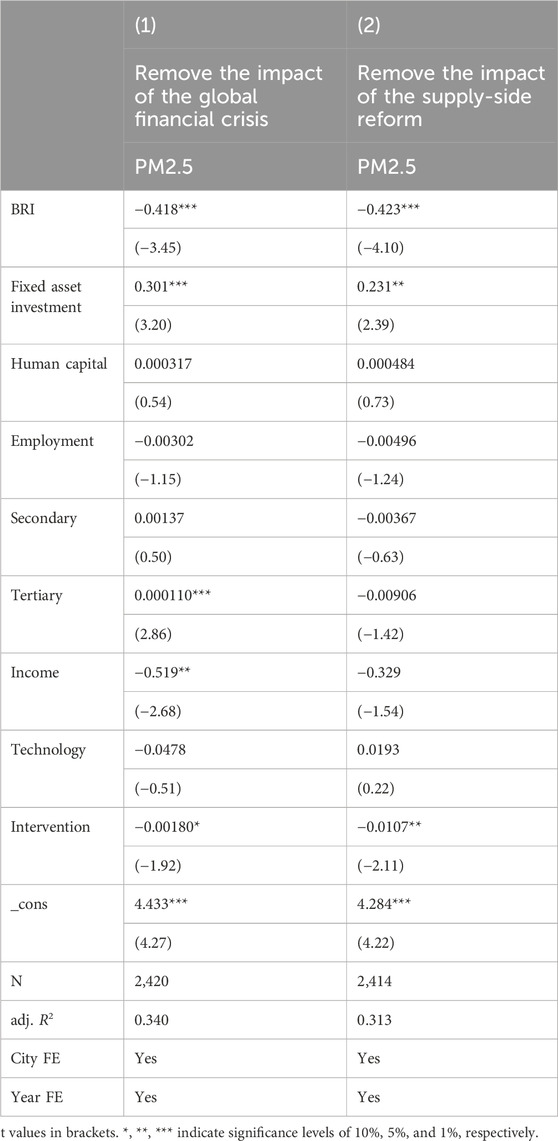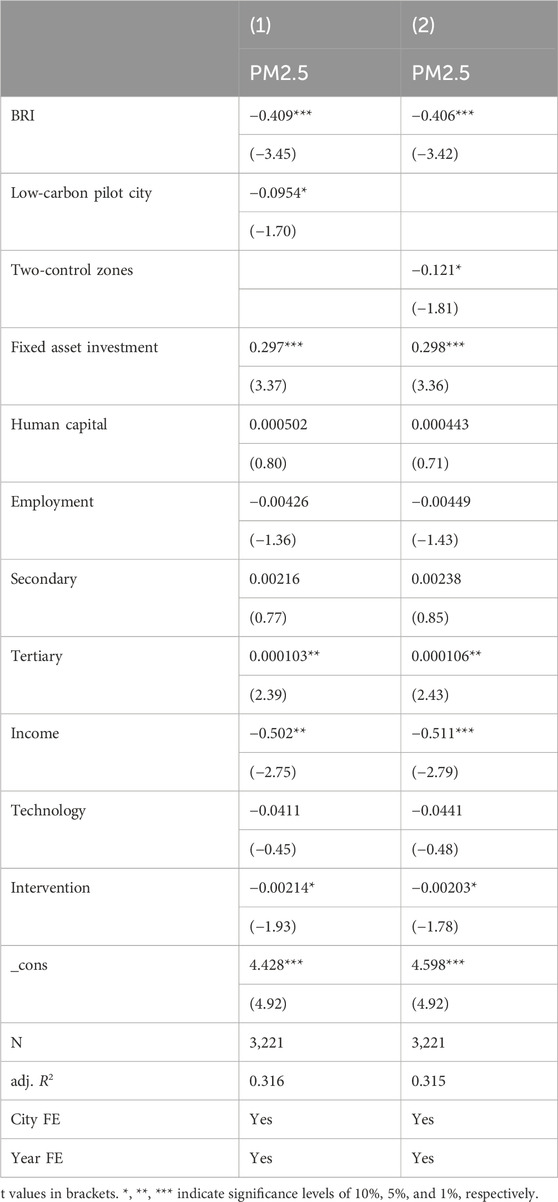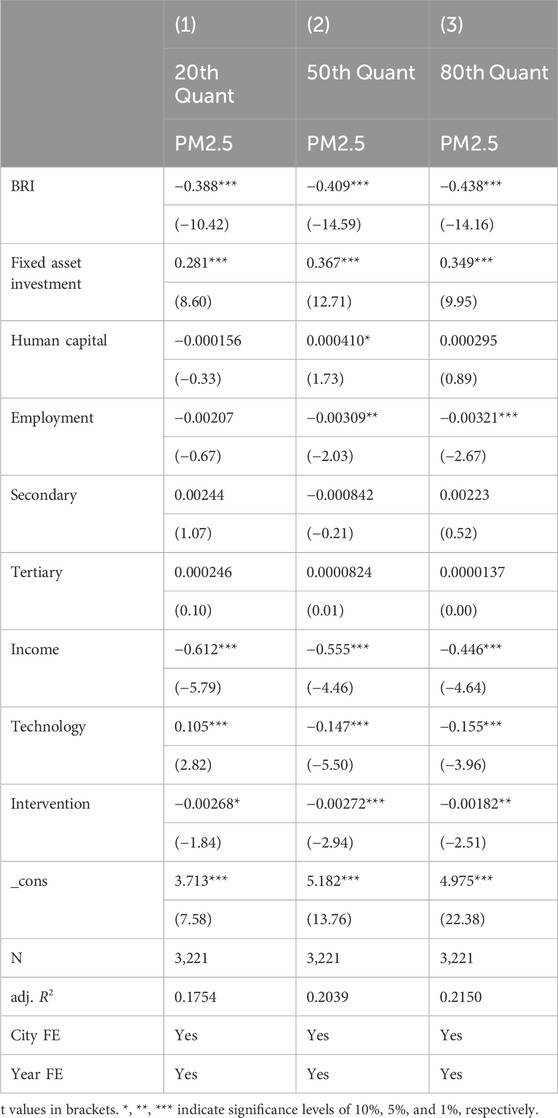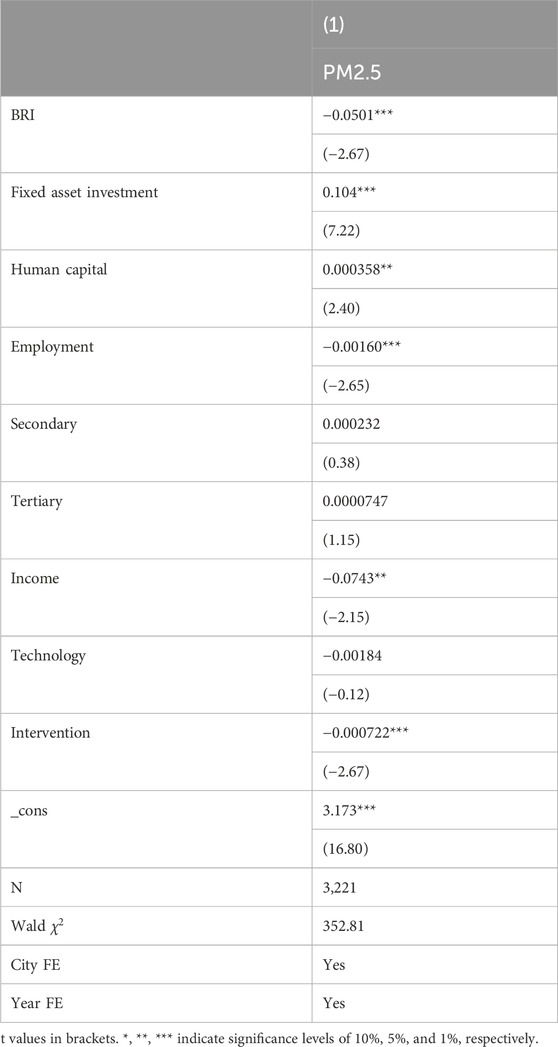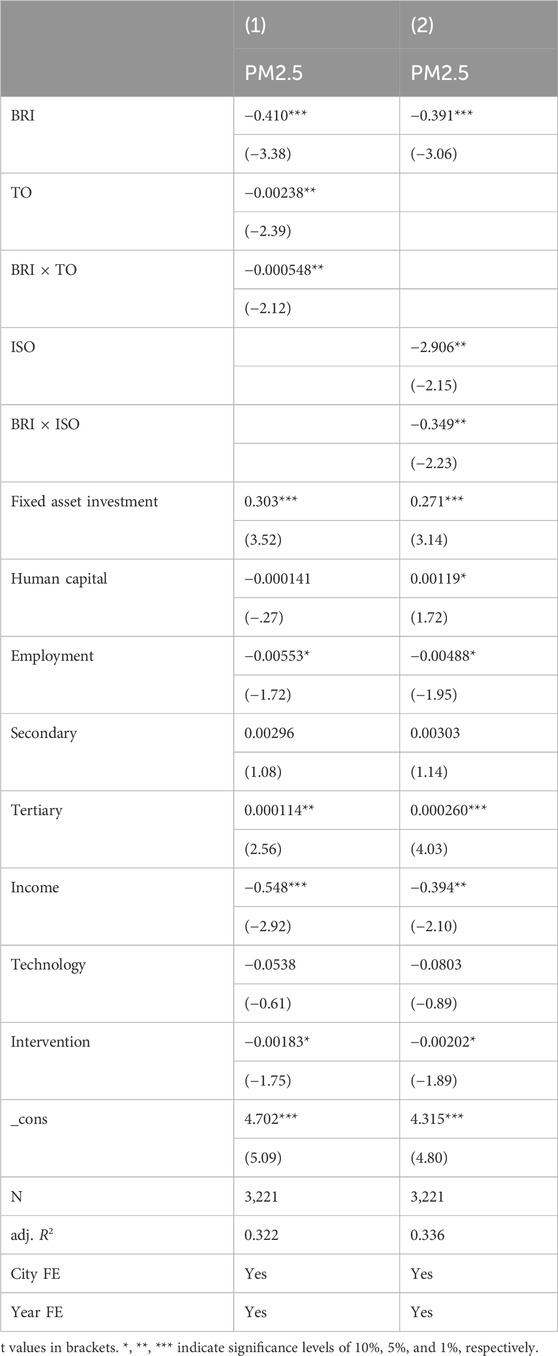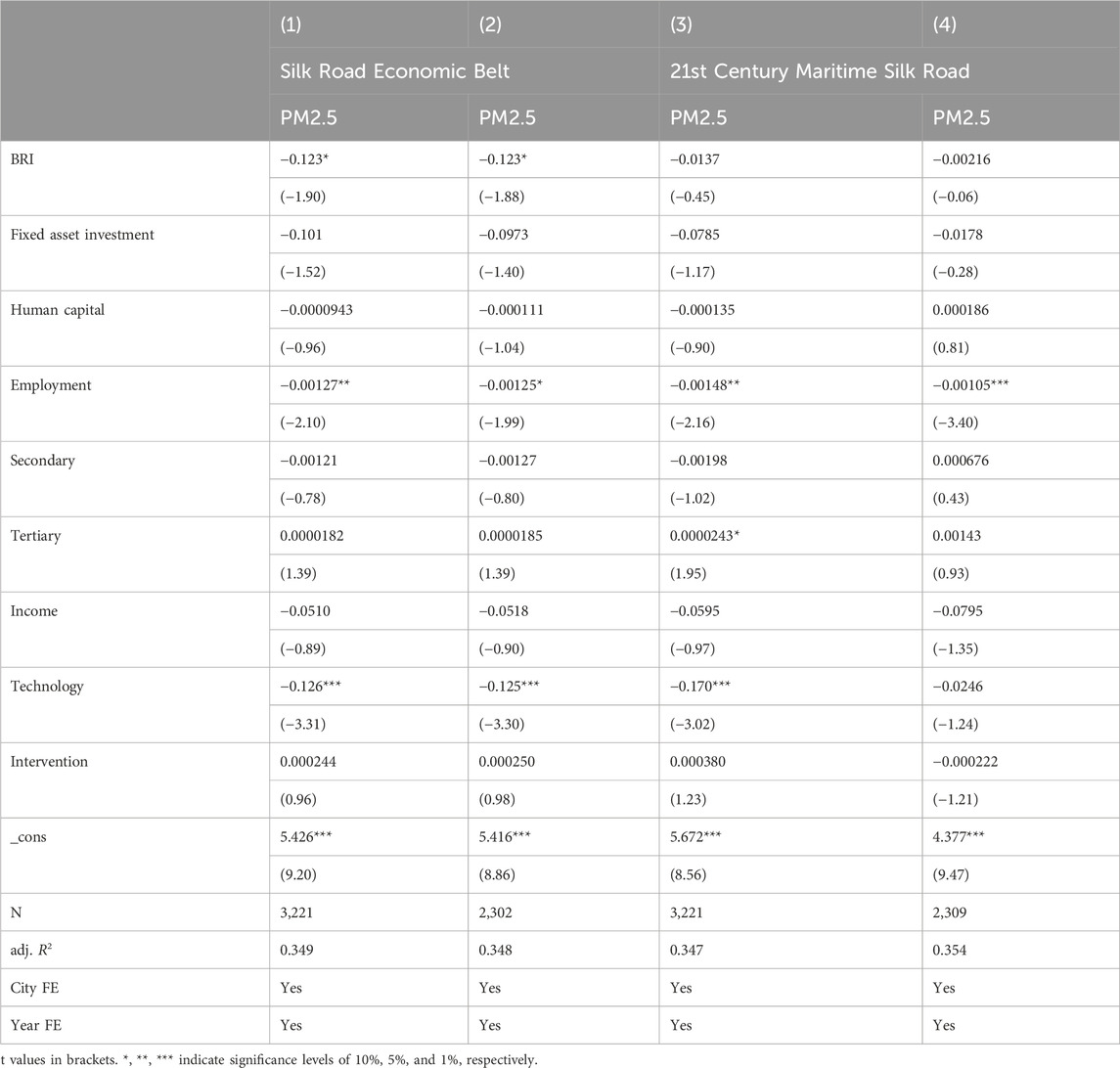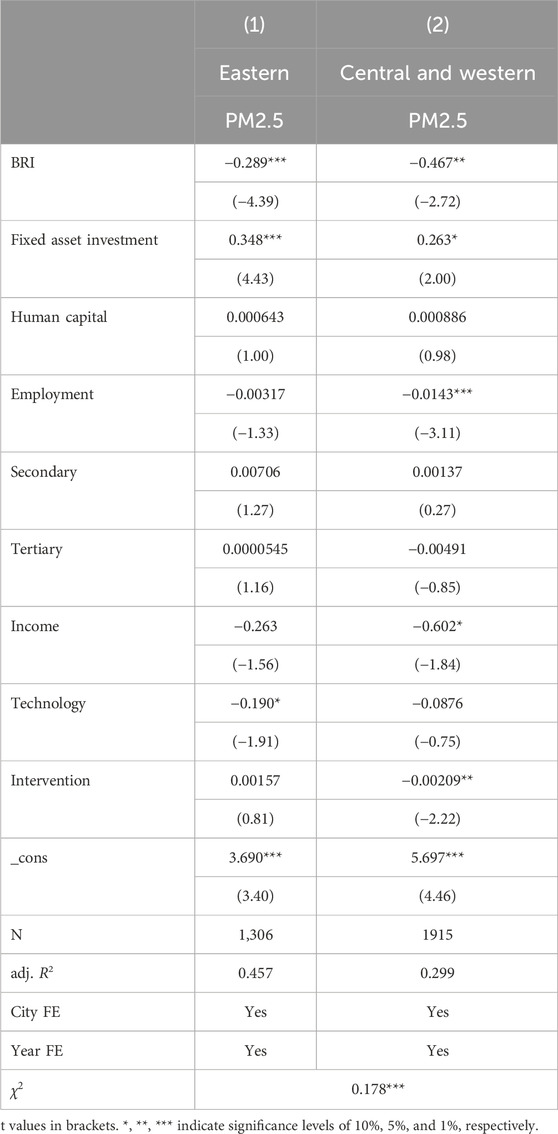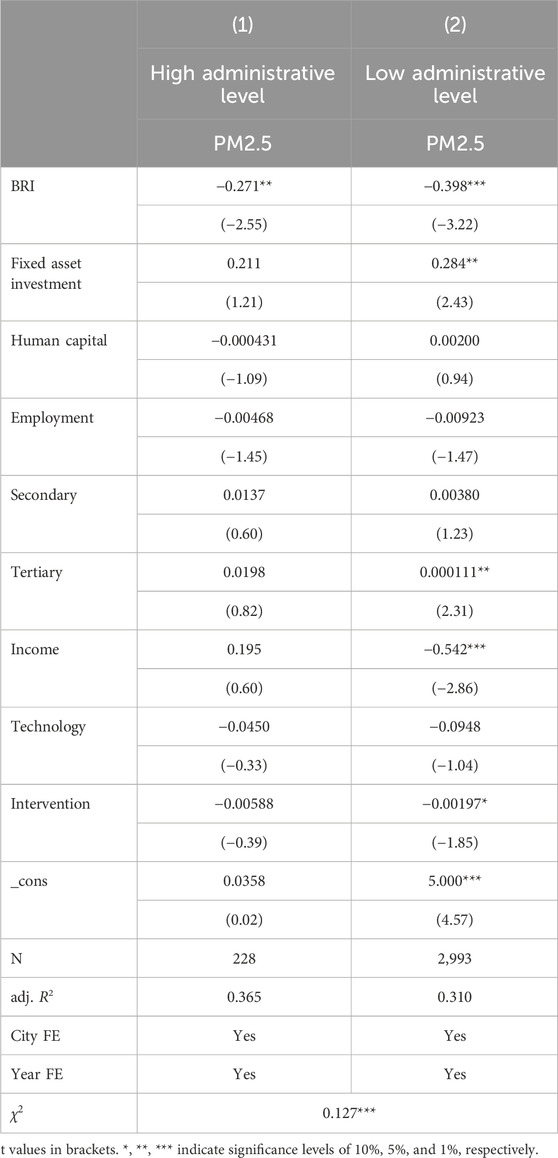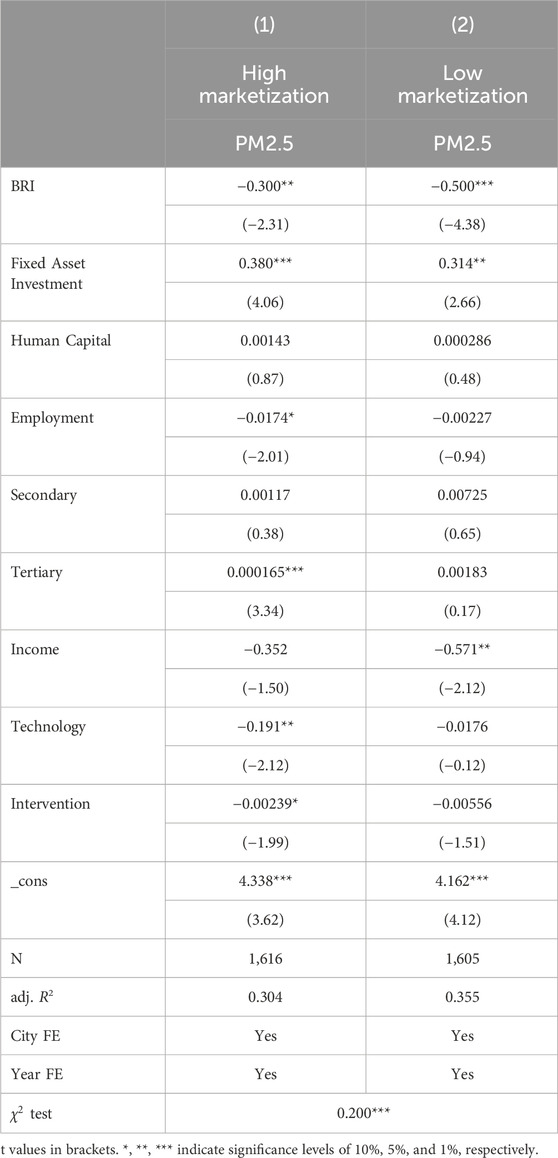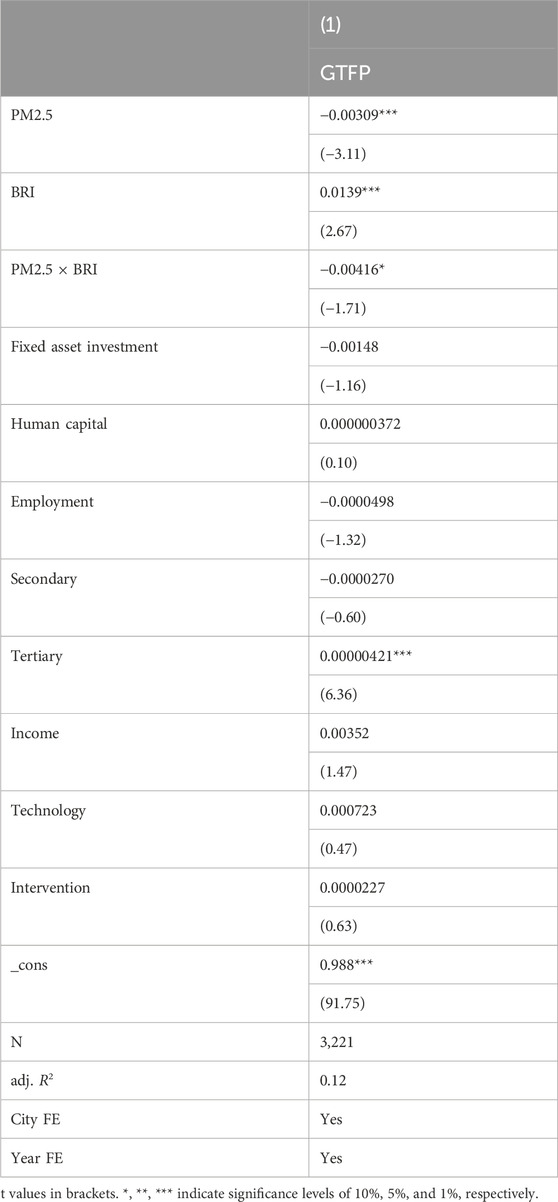- SILC Business School, Shanghai University, Shanghai, China
This study investigated the impact of the Belt and Road Initiative (BRI) on reducing smog pollution in key provinces along the route. Utilizing data from 284 prefecture-level cities in China from 2007 to 2018, this study adopted a propensity score matching-difference-in-differences approach, and conducted a series of robustness checks. The results indicate that the BRI has overall reduced particulate matter with aerodynamic diameter less than 2.5 µm (PM2.5) levels in key provinces along the route, and robustness checks find consistent results. Dynamic effect tests reveal a significant reduction in the annual average PM2.5 levels in key provinces along the route after the BRI was implemented in 2014. Tests on underlying mechanism find that the BRI mainly reduced PM2.5 levels in key provinces along the route by promoting technological innovation and optimizing industrial structure. Furthermore, heterogeneity tests find that the BRI significantly reduced PM2.5 levels only in cities of key provinces along the Silk Road Economic Belt, with variations in significance due to regional differences, city administrative levels, and marketization. In addition, the BRI has enhanced green total factor productivity in key provinces along the route by reducing PM2.5 levels. This study enriches research on the economic consequences of the BRI in terms of environmental protection, and also provides empirical support for the construction of the green “Belt and Road.”
1 Introduction
The Belt and Road Initiative (BRI) was proposed in 2013. The initiative aims at promoting policy coordination and the connectivity of facilities, unimpeded trade, financial integration, and a people-to-people bond in the international community (The State Council Information Office of China, 2020). The BRI aims to forge new paths of win-win cooperation and mutual development through enhanced bilateral and multilateral relations among participating countries (Huang, 2016). Despite its ambitious goals, the BRI has been met with skepticism, due to concerns over its potential motives behind China’s increasing foreign investment and the extensive relocation of China’s production capacities to participating countries. Critics are concerned that the BRI might result in transfer of high-polluting, high-carbon-dioxide-emission, and energy-intensive industries to less developed participating countries along the route, exacerbating environmental pollution (Li S. et al., 2022; Liu and Ma, 2023).
A great deal of research pertains to the BRI’s effect on economic development in various aspects of trade, overseas direct investment, financing, industry upgrading, corporate innovation, and economic growth (Du and Zhang, 2018; Ramasamy and Yeung, 2019; Wang and Lu, 2019; Xu S. et al., 2019). However, there have been few attempts to evaluate the effect of the BRI on China’s environment, particularly on smog pollution, a severe air pollution problem in China. Several questions loom especially large. As a developing country, China have suffered from environmental pollution during its fast-economic growth. Can the BRI bring about a mitigative effect on smog pollution and unleash new opportunities for environmental protection? What is the channel through which the BRI could reduce smog pollution? Which factors impact the effectiveness of this initiative? Very little progress has been made in addressing these issues.
Based on an evaluation of the BRI, this study provides new evidence of the positive causal link between the BRI and environmental protection. Specifically, this study evaluates the BRI’s impact on key provinces along the route, with a focus on smog pollution. Utilizing a panel dataset of 284 prefectural-level cities from 2007 to 2018, we examined the causal relationship between the BRI and smog pollution in a difference-in-differences (DID) framework. We used the particulate matter with aerodynamic diameter less than 2.5 µm (PM2.5) levels for measuring smog pollution. Besides, we investigated technological innovation and optimization of industrial structure to explore the underlying mechanism and examined heterogeneity in the effect. We found that the BRI significantly reduced PM2.5 levels in key provinces; it reduced PM2.5 levels through promoting technological innovation and optimizing industrial structure. The BRI’s effect on reducing PM2.5 levels is more pronounced in key provinces belonging to the Silk Road Economic Belt, key provinces in central and western regions, cities of low administrative levels, and cities of low marketization.
This study’s contributions are reflected in three aspects. First of all, it enriches research on the impact of the BRI on environment. This study provides new evidence for the discussion on the link between the BRI and environmental protection. Besides, we exploit the underlying path of how the BRI can reduce smog pollution from the perspective of technological innovation and optimization of industrial structure, which has not been fully discussed in previous studies. In addition, we further exploit the economic consequence of the BRI in reducing smog pollution by examining how promoting the BRI affects green total factor productivity (GTFP).
The remainder of this paper is organized as follows. Section 2 reviews related literature, introduces the BRI’s institutional background, and develops the hypothesis. Section 3 describes the empirical framework, and Section 4 reports the baseline empirical results and robustness checks. Section 5 is devoted to tests on underlying mechanism, heterogeneity tests, and further economic consequences. Section 6 concludes and discusses policy implications.
2 Related literature and hypothesis development
2.1 Related literature
Previous research has focused on two main contradicting viewpoints regarding the impact of the BRI on environment. Some studies argued that the BRI has a positive impact on environment. Cao et al. (2021) found that the BRI has a certain positive impact on environmental improvement for participating countries of the BRI, but the extent of the impact depends on environmental quality. Su et al. (2022) found that the BRI promotes environmentally friendly practices and lowers carbon footprints of participating countries of the BRI. Xin and Wang (2022) found that the BRI has significantly reduced carbon intensity in participating countries of the BRI by promoting green economic growth, enhancing green technology, and upgrading industrial structure. Besides, Yu et al. (2021) found that the BRI has a reducing effect on environmental pollution in key provinces along the route, using three industrial pollutants, industrial wastewater, soot, and sulfur dioxide as the proxy of environmental pollution. Mahadevan and Sun (2020) found that the BRI has led to a reduction in pollution through China’s foreign direct investment efforts, particularly benefiting the western and eastern regions of China. Yin and Wang (2020) found that the atmospheric environmental efficiency1 in key provinces along the route has remained relatively low over a span of 6 years since the implementation of the BRI. Increasing GDP per capita and promoting technological progress are potential mechanism of enhancing atmospheric environmental efficiency in key provinces, while energy consumption structure has a negative effect. Cao et al. (2022) found that with the implementation of the BRI, this is a gradual improvement with considerable potential for energy conservation and emission reduction. Furthermore, Zhao and Liu (2020) found that green financial policies can significantly reduce carbon emissions in key provinces along the route. Moreover, Du et al. (2022) argued that the BRI aims to balance economic development with eco-environmental protection, focusing on reducing environmental pollution through sustainable practices.
On the contrary, some studies found a negative impact of the BRI on environment or an ambiguous relationship between the BRI and environmental quality. Using a multi-regional input–output model, Tang et al. (2021) found that the BRI significantly increased per capita consumption-based carbon dioxide emission. Besides, Li B. et al. (2022) found that developing countries participating in the BRI suffer the heaviest smog pollution by having the highest PM2.5 levels and the highest population-weighted exposure level, with the fastest increases observed in the least developed countries. High-risk areas are identified primarily in South Asia, the Arabian Peninsula, and parts of China, thus providing a basis for targeted air pollution control policies. Furthermore, some studies found a negative relationship between the initiative and PM2.5 levels. The BRI promotes urbanization, and urbanization and PM2.5 levels exhibit a coordinated increase in fast developing regions of China (Li et al., 2016). However, within the key provinces along the route, the correlation between urbanization and PM2.5 levels vary. For instance, urbanization led to increased energy pollution emissions and caused dynamic changes in PM2.5 concentrations (Wei et al., 2021). Meanwhile, Fang et al. (2020) found that energy intensity and per capita electricity consumption are the main drivers of PM2.5 concentrations by analyzing the spatio-temporal distribution of PM2.5 concentrations in participating countries of the BRI.
Regarding the issue of pollution transfer, Cai et al. (2018) argued that China has become a pollution haven for many developed countries, with 19 developing countries acting as China’s pollution havens. Regarding pollution emission levels, Lin (2016) found that there are significant disparities in environmental pollution and green development levels among key provinces along the route; eastern regions have relatively advanced green development and higher economic development levels than central and western regions, but eastern regions also have higher pollution emissions. Huo and Li (2018) found that compared with neighboring countries, China’s border provinces have higher carbon emission levels. Additionally, the green development levels in these border provinces vary substantially. Zhang et al. (2022) found that there is a spatial spillover of air pollution in key provinces along the route. In terms of economic development and environmental pollution, Xu W. et al. (2019) found that the overall economic growth has a positive effect on reducing air pollution. However, increases in the number of vehicles, energy consumption, and the secondary industry activities have a negative impact on the environment. Omri and Hadj (2020) found that GDP per capita, the number of permanent residents, and foreign direct investment significantly affect the growth of urban carbon emissions, while the increase in per capita disposable income of urban residents reduces urban carbon emissions. Regarding the distribution of PM2.5 levels, Mu et al. (2021) found remarkable regional differences in PM2.5 concentrations, with high concentrations in plain and densely populated areas like the North China Plain and low concentrations in Qinghai-Tibet Plateau. Regarding policy recommendations, Wang et al. (2022) examined the relationship between material footprint (MF) and economic growth in participating countries of the BRI. They found that while economic growth has led to increased MF, the coupling varies across regions and income levels. High-income countries experienced better decoupling, and economic growth was achieved with relatively lower increases in MF. The study emphasizes the need for strategic policies and industrial restructuring to promote sustainable development of participating countries of the BRI, as green industries play a crucial role in minimizing environmental impact during economic expansion.
2.2 Institutional background
China’s opening up and economic reforms in the past three decades have achieved remarkable success. However, when describing the next period of economic growth, President Xi claimed that China’s economic development entered a “new normal” stage in 2014 (China Daily, 2014). This concept is widely used to describe the fact that annual GDP growth has slowed to 7.0–7.5 percent from the double-digit levels of the high-growth period. This is attributed to the now weakened traditional driving forces of growth; that is, the output growth rates of the labor and capital factors that were originally relied on have decreased (Li and Zhang, 2015). Nonetheless, during this long-term extensive development, more attention was paid to quantitative growth, ignoring qualitative economic development and creating bottleneck problems such as overcapacity and inefficient resource allocation (Wang and Johansson, 2013). Under this new normal, opening up further to international trade and strengthening economic cooperation have become important ways to promote economic development. In the Chinese government’s 2014 work report, Premier Li proposed that facilitating opening up to force domestic economic reform and structural transformation would be a focus in the 2014 work deployment (The State Council of the People’s Republic of China, 2014).
In September and October 2013, China put forward the major initiatives of jointly constructing the Silk Road Economic Belt and the 21st Century Maritime Silk Road, which have attracted great attention. As of 2017, in the 4 years since China put forward the BRI, it has signed production capacity cooperation agreements with 37 countries, and a total of more than 5,000 trains have traveled between China and countries along the European route, connecting two-thirds of the provinces along the route, and flights to countries along the route have been organized. Flights to countries along the route are also distributed in 26 provinces along the route, and 29 provinces have set up industrial parks.
By capitalizing on the synergies of participating countries along the expanding route, the BRI bifurcates into two corridors: the Silk Road Economic Belt, which spans eight Chinese provinces (Xinjiang, Shaanxi, Gansu, Ningxia, Qinghai, Chongqing, Yunnan, and Guangxi), and the 21st Century Maritime Silk Road, encompassing five provinces (Shanghai, Fujian, Guangdong, Zhejiang, and Hainan). The other five key provinces are Inner Mongolia, Heilongjiang, Jilin, Liaoning, and Tibet. (Lam et al., 2018). These key provinces, with their unique geographical location and developed transportation infrastructure, are highly concentrated in business, people, logistics, capital, and information flows, and are responsible for promoting the transformation of China’s industries and the construction of the green Belt and Road. Figure 1 visualizes the key provinces along the route in China.
2.3 Hypothesis development
Enhancing technological innovation helps enterprises reduce pollution emissions, and the BRI provides a platform for enterprises to invest overseas and enhance technological innovation, especially in high-end industries, such as transportation, energy, and communications (Du and Zhang, 2018). Lv et al. (2019) found that the BRI contributes to the development of multilateral trade and promotes the outward foreign direct investment (OFDI) of Chinese enterprises. Dunning (1993) and Pradhan and Singh (2009) argued that OFDI is conducive to the improvement of technological innovation. First of all, Chinese enterprises use the BRI platform to invest in factories and set up subsidiaries, joint ventures, and research and development (R&D) centers in participating countries or regions along the route. By doing so they can better participate in the international competitive market, acquire more cutting-edge technological innovations, and give back to parent companies through reversed technology transfer. This will improve the technological innovation capacity of Chinese enterprises through digestion, absorption, and secondary innovation (Pradhan and Singh, 2009), thus reducing the pollution emissions of Chinese enterprises. Dunning (1993) found that the number and percentage of patent applications of parent companies were lower than those of foreign subsidiaries, and OFDI promoted the technological innovation capacity of parent companies. Pradhan and Singh (2009) found that OFDI by Indian automobile companies has brought about technology and knowledge spillovers and promoted technological innovation capacities of parent companies. Besides, technological innovation requires enterprises to invest a great deal of money, and overseas subsidiaries can take over part of the peripheral and repetitive production work, so that parent companies can save the production costs and concentrate their financial resources on the R&D of the core technology, the introduction of high-end talents, and the purchase of R&D technology and products, so as to enhance the overall R&D and technological innovation capacities. Moreover, OFDI enterprises are generally given priority to take the privilege of the country’s customs services, tax incentives, and foreign exchange support policies, which can also save some of the R&D costs for OFDI enterprises (Xu and Wang, 2018) and indirectly promote technological innovation.
Under the policy background of the BRI, more and more countries are investing in China. Factor resources continue to flow and cluster in Chinese cities along the route. Resource allocation gradually tends to be rationalized, energy consumption is gradually reduced, and corporate pollution emissions are gradually reduced. The Digital Belt and Road (DBAR) integrates cloud computing, big data platform, Internet of Things, mobile Internet, and other high-tech information technology. It can promote the flow and agglomeration of factors such as labor, capital, network, and technology to Chinese cities along the route, improve the efficiency of resource allocation, and optimize the industrial structure (Shi et al., 2018), and reduce pollution emissions. Ma and Cao (2022) found that the optimization of industrial structure reduces levels of atmospheric haze. Chen and Wang (2022) found that the BRI can help upgrade and optimize the industrial structures of key provinces along the route, mainly through optimization of the investment environment and the adjustment of the relationship between supply and demand. The information technology in the DBAR can timely and efficiently coordinate and allocate labor, transportation, logistics, information, and other resources in cities along the route. It therefore reduces the transaction costs of enterprises, and promotes the flow of factor resources to low-energy consumption and low-polluting enterprises, eliminating high-energy-consumption and high-polluting enterprises. It consequently realizes the reasonable and effective allocation among industries and sectors, thus reducing the pollution emission of the whole industry (Ryzhenkov, 2016). Besides, the information technology industry in the DBAR is characterized by high technology and low pollution, which can bring competitive pressure to the traditional polluting industries in cities along the route. Not only can it force these traditional polluting industries to carry out technological innovation and R&D on clean technology, but also eliminate those traditional polluting industries and enterprises (Shi et al., 2018), thus reducing environmental pollution. Moreover, the information technology in the DBAR can timely grasp the market demand and market demand preferences of cities along the route. Once changes occur, it can quickly adjust and change the business strategy of enterprises, flexibly dispatch production factors such as labor, capital, and energy, so as to meet the real demand of the market in the cities along the route. DBAR can scientifically, accurately, and efficiently carry out product production, and reduce resource consumption.
Based on the above analysis, we propose the following hypothesis.
H1. The BRI reduces PM2.5 levels by promoting technological innovation and optimizing industrial structure.
3 Empirical framework
3.1 Explained variable
This study examines whether the BRI can reduce smog pollution in key provinces along the route. This study adopts PM2.5 levels as the measure of smog pollution. The annual data of average PM2.5 levels of 284 prefecture-level cities in China from 2007 to 2018 were gathered. The choice of the 2007–2018 period allows for a comprehensive before-and after comparison while mitigating the confounding variables introduced by a series of “Coordinated Regional Development” policies in 2019 and the pandemic in 2020. This time frame enables an accurate depiction of the evolution of PM2.5 levels, untainted by the extraordinary circumstances post-2018.
3.2 Main explanatory variables
As described earlier, we focus on the explanatory variable BRI, which is assigned according to the list of key provinces established in China. Treat equals 1 if a prefecture-level city belongs to a key designated province; otherwise, it equals 0. Post indicates whether the BRI has been launched and equals 0 before 2014 and 1 in or after 2014.
For the underlying mechanism analysis, following Kou and Liu (2017), we measure technological innovation (TO) using the average value of authorized invention patents and calculating the innovation index of 284 cities from 2007 to 2018. The city innovation index includes not only R&D investment and patents, but also innovation output, patent value, innovation and entrepreneurship, etc. It is based on the synthesis of multiple indicators, which is a more comprehensive assessment of a city’s innovation capacity.
We use the Theil index (Theil, 1967) to measure industrial structure optimization (ISO) with Equation 1:
where Y is the industrial added value, L is the number of employees in the industry, i represents the industry, and n represents the number of industrial sectors. As Y/L expresses labor productivity, the ratio between Yi/Li and Y/L measures the deviation between the current industrial structure and the equilibrium. The greater the Theil index, the less rationalized the industrial structure.
3.3 Control variables
A series of control variables are incorporated, including fixed-asset investment, human capital, urban employment rate, industrialization level, industrial structure, per capita income, technology, and government intervention. Table 1 presents the detailed definitions. All continuous variables are winsorized at the 1% and 99% percentiles to limit the influence of extreme values.
3.4 Empirical specification
Following existing literature on the impact of the BRI on environment in participating countries of the BRI (Cao et al., 2021) and studies on the effect of China’s domestic audit policy on improving air quality (Li et al., 2022), this study uses the DID method to explore the impact of the BRI on PM2.5 levels in prefecture-level cities along the route. This study divides the prefecture-level cities into four sub-samples: the treatment group (key provinces) and control group (other provinces) before and after implementing the BRI. The DID approach has two key advantages. First, the DID methodology rules out omitted time trends that are correlated with establishment of key provinces along the route and PM2.5 levels in both the treatment group and the control group. Second, the DID approach controls for constant unobserved differences between the treatment and the control groups that may bias our estimation. Accordingly, the benchmark regression specification of the DID model can be defined as Equation 2. Equation 3 specifies the term BRI.
Here, i and t represent cities and years, respectively. PM2.5 is the dependent variable, explaining the PM2.5 levels of city i in year t. BRI = 1 if city i belongs to a designed key provinces in year t; otherwise, it equals 0. X is a vector of control variables that vary with time. δ and μ represent the time fixed effect and city fixed effect, respectively, and ε is the random disturbance. BRI is the main explanatory variable of this study. It measures the difference in PM2.5 levels between cities in key provinces and cities not in key provinces after the implementation of the BRI, thereby identifying the net effect of the BRI controlling other factors that affect PM2.5 levels. If the BRI truly reduces PM2.5 levels, the coefficient
To test the underlying mechanism, we adding the interaction of BRI and the indexes that measure the technological innovation and industrial structure into the regression of Equation 4. The empirical specification is as follows.
Here, TO is technological innovation, and ISO is industrial structure optimization. If BRI truly reduces PM2.5 levels through technological innovation and optimization of the industrial structure, the coefficient
4 Materials and methods
4.1 The data
The data are gathered from the China City Statistical Yearbook, China Regional Economic Statistical Yearbook, CSMAR Database, and WIND Economic Database. The data are merged according to city and year to create the sample for the empirical analysis; there are 3,281 total observations. Although the study accounts for some of the missing data via interpolation to maintain a high degree of data consistency, areas with a significant number of missing observations are excluded. Table 2 reports the descriptive statistics of all variables.
4.2 Baseline estimates
Equation 2 is first employed to evaluate the net BRI effect on PM2.5 levels of key provinces. Table 3 reports the baseline estimation results. Column (1) shows the estimation results without incorporating the control variables. Columns (2) show the results after adding the control variables. As the results in Table 3 show, the coefficients of the policy variables are significant in both regressions. Thus, the BRI reduces the PM2.5 levels of key provinces.
4.3 Testing the parallel trend and the dynamic effect
The DID method assumes that the treatment and control groups have a parallel trend before the event. As shown in Figure 2, the TFP trend of the treatment and control groups is similar before the official BRI launch in 2014.
We exploit the exact timing of policy implementation to test whether the decrease in PM2.5 levels corresponds with the implementation, or if it precedes it. For this purpose, we estimate Equation 5 by substituting the BRI variable
We replace the regressor
In the years before the BRI launch, none of the coefficients of the lagged policy variables are significant, indicating no difference in PM2.5 levels between the treatment and control groups. The interaction terms of 2007–2012 are insignificant and are consistent with Figure 1, which confirms the parallel trend before the BRI was implemented. After implementation, the average PM2.5 levels of the treatment group decreased faster than that of the control group. The effect of the BRI is affected by local government participation and other supporting policies. With successive publicity and the implementation of the BRI, local governments have gradually deepened their understanding of the initiative, their relevant policies have improved, and their execution capabilities have increased. As seen in Table 4, after the BRI was fully launched in 2014, the significance of the coefficient increases year by year from 2015 to 2018, and its value increases gradually, that is, there are dynamic effects. The BRI policy effect increases gradually after implementation, with various regions responding to the state’s call. As the implementation deepens, policies and related support facilities in various regions gradually improve, and detailed guidance plans are implemented; hence, the BRI impact on PM2.5 reduction in key provinces exhibits a dynamic effect.
4.4 Testing policy endogeneity
A suitable control group is essential for the accuracy and credibility of the DID method. This study sets non-key provinces as the control group, ignoring the inherent differences in PM2.5 levels and other aspects between cities in the treatment and control groups, which may cause the DID method’s estimation results to be unreliable. We employ the propensity score matching (PSM) method to match cities in the treatment group with those in the control group to reduce the systemic bias and other endogeneity problems of the DID method; we thus overcome the systematic differences in the PM2.5 trends between the treatment and control groups. We conduct logit regressions on the control variables to obtain the PSM. We adopt the balance test to ensure the PSM matching is satisfactory. Table 5 shows the PSM balance test results.
The results show the standardized deviations (% bias) of variables after matching are significantly reduced, and the standardized deviations of all variables are less than 1%. Moreover, the t-test results show the differences between the treated and the control samples after matching are all insignificant. All the above indicates that the matching effect is effective.
Three common matching methods (radius, kernel density, and nearest neighbor matching) are employed to perform a robustness check. Table 6 presents the results.
From Table 6, radius, kernel density, and nearest neighbor matching generate the same results. The coefficients of the BRI term are significantly positive at the 5% level. Therefore, the BRI significantly reduces the PM2.5 levels of key provinces, further verifying the main findings.
An important premise of the DID method is that the treatment and control group selection is random, which may not be the case in this study. Unobservable factors might have influenced designation of key BRI provinces. Provinces with a higher level of economic development may first be used as key provinces to further promote BRI implementation. However, provinces with lower economic development may also be selected. Therefore, the choice of the treatment group may be susceptible to endogeneity. Given the potential endogeneity of the policy variable, an instrumental variable (IV) is determined under two conditions: an IV is (1) related to the endogenous variable and (2) unrelated to the random error term. The two-stage least squares method is adopted for the estimation. The BRI concept is inspired by the ancient Silk Road, which witnessed hundreds of years of booming trade and cultural exchanges in the Eurasian continent; we therefore select the ancient Silk Road route provinces as IVs following Duranton et al. (2014). Although the BRI aims to revive the ancient Silk Road, they are far apart in time, and the latter does not influence the PM2.5 levels of key provinces along the route. Thus, the ancient Silk Road satisfies the two conditions of an IV. The specific setting is that if a key province is among the ancient Silk Road provinces (Shaanxi, Ningxia, Gansu, Qinghai, Xinjiang, Tibet), IV = 1; otherwise, IV = 0. Meanwhile, IV × Post is selected as the IV for the term BRI. Table 7 shows the corresponding results after the IV adoption.
The regression results in Column (1) confirm the rationality of using the ancient Silk Road route provinces as IVs. The F value from the Cragg-Donald test is greater than 10, indicating that the IVs are highly correlated with the endogenous variable in the first stage regression. Column (2) shows the regression results for the second stage. The coefficient of BRI is −0.158, significant at the 1% level. Thus, after alleviating potential endogeneity problems, the basic findings remain unchanged.
Following Zhang et al. (2012), this study utilizes the generalized method of moments (GMM) in two estimations for a robustness check to further control for potential endogeneity by unobserved variables. Table 8 reports the test results of Equation 2. BRI coefficients in the two regressions remain significant.
4.5 Placebo tests
There might be policies or influencing factors other than the BRI that may induce PM2.5 abatement during the same period. To rule out the possibility that PM2.5 levels might have been reduced by other contemporaneous policies, following Liu and Zhao (2015), we perform a placebo test by falsifying the year the policy was initiated. We assume that the BRI was proposed two or 3 years before the actual date and observe the coefficient and significance of the policy variable. If the estimated coefficient of the policy variable is insignificant under the two placebo tests, the BRI reduces the PM2.5 levels in key provinces. If the two falsified policy variables are significant, BRI implementation does not necessarily cause PM2.5 abatement in key provinces. Table 9 presents the results; when assuming the BRI was proposed in 2011 or 2012, the estimated coefficient of the BRI term is not significant. Thus, BRI implementation reduces the PM2.5 levels of key provinces without interference from other policies or factors.
4.6 Testing alternative samples
This study modifies Equation 2 by incorporating lagged control variables for a robustness check to mitigate the influence of the current data. Moreover, it removes observations from 2013, when the BRI was proposed. Column (1) and (2) of Table 10 reports the regression results; BRI coefficients in both regressions remain significant.
4.7 Testing the removal of confounding effects
During the implementation of the BRI, the global financial crisis occurred in 2008. The financial crisis reduced production activities, which may have influenced PM2.5 levels. Therefore, observations before 2009 are also removed to control for confounding effects. In addition, the confounding impact of the supply-side reform (proposed in November 2015 and implemented afterward) on PM2.5 levels is then removed by removing observations after 2016. Table 11 reports the regression results; BRI coefficients in both regressions remain significant.
This study also controls contemporaneous disturbances. It removed cities that have implemented the Low-Carbon City Pilot Policy and cities in two-control zones (acid rain control zone and sulfur dioxide pollution control zone). Table 12 shows the regression results, with the BRI term being significantly negative at the 1% level. This verifies that the BRI has a significant reduction effect on PM2.5 levels in key provinces along the route, yielding robust results.
4.8 Testing alternative regression methods
We further verify robustness by conducting a simultaneous quantile regression with 1,000 bootstraps. Specifically, we perform regression analysis on the 20th, 50th, and 80th PM2.5 quantiles using Equation 2. The advantage of using this estimate is that it allows us to test how the BRI affects the PM2.5 levels of cities with different PM2.5 levels. The results in Table 13 are consistent with the baseline results in Table 3: there is a pronounced negative relationship between the BRI and PM2.5. For cities with low PM2.5 levels, the BRI further reduces PM2.5, while for cities with high PM2.5 levels, the BRI provides timely assistance regarding PM2.5 abatement. The BRI also exhibits a negative impact for regions with intermediate PM2.5 levels.
Given that province- and prefecture-level variables are included in the regression, we utilize a hierarchical mixed model to re-estimate Equation 2. Martin et al. (2007) note that a hierarchical mixed model is more suitable for separating provincial- from prefecture-level impacts. Table 14 presents the results.
5 Further tests
5.1 Underlying mechanism
As noted, the BRI significantly reduces the PM2.5 levels. From the hypothesis and model setup, we create interaction terms (
The results in Table 15 show that the regression coefficients on the interaction terms are significantly negative at the 1% level, indicating that the BRI can reduce PM2.5 levels by promoting technological innovation and optimizing industrial structure. From the perspective of technological innovation, the BRI provides a platform for enterprises to invest overseas and enhance technological innovation, which in turn helps enterprises reduce pollution emissions. Chinese enterprises use the platform of BRI to invest in factories and set up subsidiaries, joint ventures and R&D centers in participating countries or regions along the route. The reversed technology transfer helps improve the technological innovation capacity of Chinese enterprises, thus reducing the pollution emissions of Chinese enterprises. The relatively lower production costs in overseas subsidiaries can facilitate parent firms to concentrate its financial resources on the R&D and therefore enhance the overall R&D and innovation ability. Favorable policies for firms actively participating in the BRI also indirectly promote technological innovation. From the industrial structure perspective, under the policy background of the BRI, factor resources continue to flow and cluster in Chinese cities along the route as more countries are investing in China. DBAR integrates high-tech information technology and promotes the flow and agglomeration of production factors to Chinese cities along the route, improve the efficiency of resource allocation and optimize the industrial structure, and reduce pollution emissions. The information technology in the DBAR can timely and efficiently coordinate and allocate resources in cities along the route, and promotes the flow of factor resources to low-energy consumption, low-pollution enterprises, eliminating high-energy-consumption and high-pollution enterprises. The information technology industry in the DBAR is characterized by high technology and low pollution, which induces traditional heavy polluting industries to develop technological innovation and R&D on clean technology, thus reducing environmental pollution.
5.2 Heterogeneity tests
In terms of initiative layout and mode of transportation, the BRI can be divided into the Silk Road Economic Belt and the 21st Century Maritime Silk Road. According to the description of the regional opening plans of the Vision and Actions, we regard Shanghai, Fujian, Guangdong, Zhejiang, and Hainan as belonging to the 21st Century Maritime Silk Road and other provinces as belonging to the Silk Road Economic Belt. We believe that although these provinces are all designated as key provinces, there are significant differences in the implementation priorities, development levels, and historical factors among the provinces. By contrast, the provinces belonging to the 21st century Maritime Silk Road are relatively more developed areas along the eastern coast of China, with relatively higher levels of initial economic development. Therefore, it is necessary to distinguish in the analysis the key provinces belonging to the two Roads. The grouping regression results are listed in Table 16.
The control group in column (1) includes cities of key provinces along the 21st Century Maritime Silk Road, while the control group in column (2) excludes cities of key provinces along the 21st Century Maritime Silk Road. The control group in column (3) includes cities of key provinces along the Silk Road Economic Belt, and the control group in column (4) excludes cities of key provinces along the Silk Road Economic Belt. The BRI estimation coefficients in Column (1) and (2) are significantly negative; by contrast, the results in Column (3) and (4) show that the BRI plays a relatively limited role in reducing PM2.5 levels in the provinces of the 21st century Maritime Silk Road, although they are also designated as key provinces. This result indicates that the BRI mainly improves TFP in the eight key provinces belonging to the Silk Road Economic Belt. This can be attributed to the relatively worse economic conditions of these regions, higher polluting levels, lower technological innovation, and underdeveloped industrial infrastructure. These late-development advantage help these provinces outperform the coastal provinces of the 21st century Maritime Silk Road in reducing pollution, thereby making the BRI’s effect on reducing PM2.5 levels more significant.
As China is a vast country, the resource endowment, economic base, and infrastructure level of cities differs across regions. We separate the samples into eastern and central and western regions. As shown in Table 17, BRI is more significant in the central and western region.
The central region plays an important role in China’s regional development by undertaking industrial transfer from the east and promoting the development of the west, it mainly focuses on domestic trade (Bai et al., 2020). The economic foundation of the western region is relatively weaker, and the implementation of the BRI can effectively mitigate its lack of economic growth power (Zhang et al., 2018). The impact of BRI will be further expanded through ethnic policies and resource endowment toward the western region. Moreover, the central and western regions have taken up the Silk Road Economic Belt, which has led to considerable trade among the countries along the route. The eastern coastal area has the natural advantage for developing an export-oriented economy, however, due to insufficient preferential policies for economic growth, the marginal effect of the implementation of the BRI is smaller.
Cities with different administrative levels have different resource levels, institutional arrangements, and management powers, so that they can provide different preferential and policies for implementing the BRI; thus, they have heterogeneous effects. The regression results for the subsamples of sub-provincial cities (high administrative level), and municipalities and prefecture-level cities (low administrative level) are shown in Table 18.
We find that the mitigating effect of the BRI on PM2.5 levels is significant in both regressions, with the effect being more pronounced in cities of low administrative level. Municipals and prefecture-level cities have a higher BRI impact than sub-provincial cities because of their lower economic development and higher pollution levels. Specifically, the initiative can bring about more marginal effect to late-development regions, and the local government has utilized BRI policy resources and benefits, significantly reducing the area’s PM2.5 levels.
The OFDI of China in the BRI participating countries has surpassed US$50 billion. The target of unimpeded trade is promoting trade and investment facilitation and improving the business environment (The State Council Information Office of China, 2019), which would be finally reflected in improved market mechanisms. Market mechanism creates a competition and investment effect among enterprises. Therefore, whether the local market operation mechanism is complete could partially determine the impact of the BRI on PM2.5 levels. Here, we introduce the marketization index of China’s provinces (Wang et al., 2021). Based on the marketization index mean, cities are grouped into high marketization degree and low marketization degree. The results of the separate regressions are presented in Table 19.
The mitigating effect of the BRI on PM2.5 levels is significant in both regressions, with a more pronounced effect in low-marketization cities. The market operation mechanism in high-marketization cities is relatively complete. For cities with a high degree of marketization, local governments have taken measures to effectively improve the market mechanism and business environment to promote economic growth and reduce pollution. In comparison, the market operation mechanism of low-marketization cities is not complete, and local enterprises lack awareness of R&D and improving efficiency. The implementation of the BRI could encourage the implementation of operational and post-operational oversight systems by local governments in low-marketization cities, which could stimulate market vitality and, in turn, improve marketization. Through improving marketization in regions with a low degree of marketization can establish a sound legal system and intellectual property protection measures, which will promote enterprises to increase R&D investment. Besides, through improving marketization in regions with a low degree of marketization, a fierce market competition and a more optimized price transfer mechanism will be established. It helps reduce the uncertainty of enterprise innovation returns, enhance the R&D and innovation vitality of the private science and technology enterprises with a strong preference for innovation, and increase the play of innovation to treat pollution and reduce smog pollution.
5.3 Economic consequences
Using micro-level data, Gu and Yan (2021) found that air pollution control policies reduce PM2.5 levels and promote total factor productivity in listed firms in China. This study further assessed whether the BRI promotes the GTFP of key provinces along the route by reducing PM2.5 levels. We adopted the epsilon-based measure to calculate radical and non-radial distance (Tone and Tsutsui, 2010), which is beyond the ability of traditional non-parametric methods (e.g., data envelopment analysis and slacks-based measure distance function model). Table 20 reports the DID estimation results of Equation 6.
From the regression results in Table 20, the interaction term PM2.5
6 Conclusion and policy implications
This study adopts the PM2.5 levels as the measure of smog pollution of 284 prefecture-level cities in China. Utilizing the varying degree of different regions benefiting from the BRI, we conducted a quasi-natural experimental design for BRI to evaluate the impact of the BRI on the PM2.5 levels of key provinces using a DID framework. The empirical results show that the BRI has significantly reduced the PM2.5 levels in key provinces, and the promoting effect is consistent in various robustness checks. Moreover, the BRI demonstrates dynamic effects, characterized by stronger impact every year. Moreover, we found that the BRI can reduce PM2.5 levels through promoting technological innovation and optimizing industrial structure. Furthermore, the BRI’s impact on PM2.5 levels also exhibits heterogeneous effects. Furthermore, through reducing PM2.5 levels, the BRI enhances GTFP of key provinces along the route.
Based on the empirical results, this study proposes the following policy implications. This study confirms the beneficial impact of the BRI on lowering PM2.5 levels in key provinces along the route, advocating for the continued implementation of the BRI. To further mitigate environmental and pollution transfer issues, it is advised to expand green industries and embrace sustainable development. Besides, the initiative is shown to enhance GTFP by reducing PM2.5 levels, thus underscoring the environmental and economic benefits of maintaining this initiative. Tests on the underlying mechanism detect a positive relationship between technological innovation and the reduction of PM2.5 levels in key provinces. We recommend governmental support through policy incentives, increased funding, and financial subsidies for innovation-driven enterprises. Furthermore, enhancing technological collaboration among the key provinces could bolster technological advancements and demonstrate the critical mechanism of innovation in environmental sustainability. The study also highlights the importance of optimizing industrial structure to further curtail PM2.5 pollution. The government is encouraged to expedite the transition towards a more service-oriented economy while diminishing the share of the secondary sector. Not only does such restructuring contribute to reduced PM2.5 levels, but also aligns with the broader environmental and economic objectives of the BRI. Heterogeneity tests found that the BRI’s influence on PM2.5 reduction varies regionally. The disparity suggests a need for tailored environmental pollution control policies, particularly in regions where PM2.5 reduction is less pronounced. This will allow more uniform environmental improvements across all areas involved in the initiative.
We conclude by outlining related questions that are beyond this study’s scope. Despite the positive findings, our results cannot answer the broader questions of whether the BRI reduces other environmental pollution. Using PM2.5 as the sole parameter of environmental pollution may not fully reflect the complexity of the issue. Besides, while this study has investigated the role of technological innovation and the optimization of industrial structures as potential underlying mechanism, more underlying mechanism remains under researched. Furthermore, although this study conducts a battery of heterogeneity tests, expansion can be done on more heterogeneous effects on different dimensions, such as cities of different levels of economic development and different industrial structure. These issues warrant future research.
Data availability statement
The data analyzed in this study is subject to the following licenses/restrictions: The data that support the findings of this study are in Chinese and available from the corresponding author upon reasonable request. Requests to access these datasets should be directed to MW, d3VtYW9ndW9Ac2h1LmVkdS5jbg==.
Author contributions
JJ: Data curation, Formal Analysis, Investigation, Methodology, Software, Validation, Writing–original draft. MW: Conceptualization, Data curation, Formal Analysis, Investigation, Methodology, Software, Validation, Writing–review and editing.
Funding
The author(s) declare that no financial support was received for the research, authorship, and/or publication of this article.
Conflict of interest
The authors declare that the research was conducted in the absence of any commercial or financial relationships that could be construed as a potential conflict of interest.
Publisher’s note
All claims expressed in this article are solely those of the authors and do not necessarily represent those of their affiliated organizations, or those of the publisher, the editors and the reviewers. Any product that may be evaluated in this article, or claim that may be made by its manufacturer, is not guaranteed or endorsed by the publisher.
Footnotes
1Atmospheric environmental efficiency generally refers to the reduction of atmospheric pollution for the same economic output.
References
Bai, Z. L., Sun, Y. H., and Wei, Z. (2020). Economic effect evaluation and location selection of the establishment policy of free trade area. Int. Econ. Trade Res. 36 (8), 4–22. doi:10.13687/j.cnki.gjjmts.2020.08.001
Cai, X., Che, X., Zhu, B., Zhao, J., and Xie, R. (2018). Will developing countries become pollution havens for developed countries? an empirical investigation in the belt and road. J. Clean. Prod. 198, 624–632. doi:10.1016/j.jclepro.2018.06.291
Cao, X., Teng, C., and Zhang, J. (2021). Impact of the belt and road initiative on environmental quality in countries along the routes. Chin. J. Popul. Resour. Environ. 19 (4), 344–351. doi:10.1016/j.cjpre.2022.01.007
Cao, X., Zhang, H., Huang, X., and Li, P. (2022). Can the belt and road initiative reduce pollution in enterprises? evidence from quasi-natural experiments. Energy Rep. 8, 11683–11694. doi:10.1016/j.egyr.2022.09.012
Chen, R. H., and Wang, F. (2022). Can the belt and road initiative promote the optimization of industrial structure of provinces and cities along the route?. J. Nankai Univ. (Philosophy, Literature Soc.). 2, 170–182.
China Daily (2014). New normal in economic development. Available at: https://www.chinadaily.com.cn/china/19thcpcnationalcongress/2017-10/05/content_32869258.htm (Accessed May 15, 2024).
Du, J., and Zhang, Y. (2018). Does one belt one road initiative promote Chinese overseas direct investment?. China Econ. Rev. 47, 189–205. doi:10.1016/j.chieco.2017.05.010
Du, X., Qin, Y., and Huang, C. (2022). Status and prospect of ecological environment in the belt and road initiative regions. Int. J. Environ. Res. Public Health. 19, 17091. doi:10.3390/ijerph192417091
Dunning, J. H. (Editor) (1993). United nations library on transnational corporations. 1, the theory of transnational corporations. London, UK: Routledge.
Duranton, G., Morrow, P. M., and Turner, M. A. (2014). Roads and trade: evidence from the US. Rev. Econ. Stud. 81 (2), 681–724. doi:10.1093/restud/rdt039
Fang, K., Wang, T., He, J., Wang, T., Xie, X., Tang, Y., et al. (2020). The distribution and drivers of PM2.5 in a rapidly urbanizing region: the belt and road initiative in focus. Sci. Total Environ. 716, 137010. doi:10.1016/j.scitotenv.2020.137010
Gu, H., and Yan, W. (2021). Impact of air pollution control on total factor productivity of firms: a quasi natural experiment based on the ambient air quality standards (2012). China Population,Resources Environ. 31 (11), 59–67.
Huang, Y. (2016). Understanding China’s belt and road initiative: motivation, framework and assessment. China Econ. Rev. 40, 314–321. doi:10.1016/j.chieco.2016.07.007
Huo, Q., and Li, G. (2018). Green development index of border provinces under the belt and road initiative. Ecol. Econ. 34 (10), 52–56.
Kou, Z., and Liu, X. (2017). FIND report on city and industrial innovation in China. Shanghai, China: Fudan Institute of Industrial Development, School of Economics, Fudan University.
Lam, J. S. L., Cullinane, K. P. B., and Lee, P. T. W. (2018). The 21st-century maritime silk road: challenges and opportunities for transport management and practice. Transp. Rev. 38 (4), 413–415. doi:10.1080/01441647.2018.1453562
Li, B., Hu, J., Chen, G., Xiao, D., and Cheng, S. (2022). The environmental effects of regional economic cooperation: evidence from the Belt and Road Initiative. Front. Environ. Sci. 10. doi:10.3389/fenvs.2022.1020502
Li, G., Fang, C., Wang, S., and Sun, S. (2016). The effect of economic growth, urbanization, and industrialization on fine particulate matter (PM2.5) concentrations in China. Environ. Sci. and Technol. 50 (21), 11452–11459. doi:10.1021/acs.est.6b02562
Li, S., Shafi, S., Zou, B., Liu, J., Xiong, Y., and Muhammad, B. (2022). PM2.5 concentration exposure over the belt and road region from 2000 to 2020. Int. J. Environ. Res. Public Health 19 (5), 2852. doi:10.3390/ijerph19052852
Li, G., Wu, M., and Sun, R. (2022). Will China’s audit of natural environmental resources promote green sustainable development? evidence from PSM-DID analysis based on substantial and strategic pollution reduction. PLoS ONE 17 (12), e0278985. doi:10.1371/journal.pone.0278985
Li, Y., and Zhang, X. (2015). The new normal: the logic and perspective of economic development. Econ. Res. J. 50 (5), 4–19.
Lin, Y. (2016). Green development in Chinese provinces under the background of the belt and road initiative: current situation, problems, and countermeasures. Chin. J. Environ. Manag. 8 (2), 42–46. doi:10.16868/j.cnki.1674-6252.2016.02.042
Liu, M., and Ma, H. (2023). Untangling the effects of the belt and road initiative on carbon dioxide emissions. J. Environ. Manag. 325, 116628. doi:10.1016/j.jenvman.2022.116628
Liu, R., and Zhao, R. (2015). Is the western development a growth drive or a policy trap? an analysis based on PSM-DID method. China Ind. Econ. 6, 32–43. doi:10.19581/j.cnki.ciejournal.2015.06.004
Lv, Y., Lu, Y., Wu, S., and Wang, Y. (2019). The effect of the belt and road initiative on firms’ OFDI: evidence from China’s greenfield investment. Econ. Res. J. 54 (9), 187–202.
Ma, T., and Cao, X. (2007). The effect of the industrial structure and haze pollution: spatial evidence for China. Environ. Sci. Pollut. Res. 29, 23578–23594. doi:10.1007/s11356-021-17477-4
Mahadevan, R., and Sun, Y. (2020). Effects of foreign direct investment on carbon emissions: evidence from China and its belt and road countries. J. Environ. Manag. 276, 111321. doi:10.1016/j.jenvman.2020.111321
Martin, K. D., Cullen, J. B., Johnson, J. L., and Parboteeah, K. P. (2007). Deciding to bribe: a cross-level analysis of firm and home country influences on bribery activity. Acad. Manag. J. 50 (6), 1401–1422. doi:10.5465/amj.2007.28179462
Mu, H., He, C., Nguyen, T. M., Wang, D., Zhou, X., Yang, L., et al. (2021). Spatiotemporal distribution characteristics and population exposure risks to PM2.5 in countries along the belt and road. Acta Sci. Circumstantiae 41 (6), 2229–2240. doi:10.13671/j.hjkxxb.2020.0488
Omri, A., and Hadj, T. B. (2020). Foreign investment and air pollution: do good governance and technological innovation matter?. Environ. Res. 185, 109469. doi:10.1016/j.envres.2020.109469
Pradhan, J. P., and Singh, N. (2009). Outward FDI and knowledge flows: a study of the indian automotive sector. Int. J. Institutions Econ. 1 (1), 156–187.
Ramasamy, B., and Yeung, M. C. H. (2019). China’s one belt one road initiative: the impact of trade facilitation versus physical infrastructure on exports. World Econ. 42, 1673–1694. doi:10.1111/twec.12808
Ryzhenkov, M. (2016). Resource misallocation and manufacturing productivity: the case of Ukraine. J. Comp. Econ. 44 (1), 41–55. doi:10.1016/j.jce.2015.12.003
Shi, D., Ding, H., Wei, P., and Liu, J. (2018). Can smart city construction reduce environmental pollution?. China Ind. Econ. 6, 117–135. doi:10.19581/j.cnki.ciejournal.2018.06.008
Su, X., Li, Y., Fang, K., and Long, Y. (2022). Does China’s direct investment in “Belt and Road Initiative” countries decrease their carbon dioxide emissions?. J. Clean. Prod. 339, 130543. doi:10.1016/j.jclepro.2022.130543
Tang, D., Li, X., Xu, X., Liu, X., Zhang, H., Shi, H., et al. (2021). Does the belt and road initiative really increase CO2 emissions?. Ann. Am. Assoc. Geogr. 112 (4), 948–967. doi:10.1080/24694452.2021.1941747
The State Council Information Office of China (2019). Unimpeded trade. State Counc. Inf. Office China, 182–185. Available at: http://english.scio.gov.cn/featured/chinakeywords/2019-07/11/content_74977490.htm (Accessed May 15, 2024).
The State Council Information Office of China (2020). What is five-pronged approach?. State Counc. Inf. Office China. Available at: http://english.scio.gov.cn/beltandroad/2020-08/04/content_76345571.htm (Accessed May 15, 2024).
The State Council of the People’s Republic of China (2014). Report on the work of the government. Available at: http://english.www.gov.cn/archive/publications/2014/08/23/content_281474982987826.htm (Accessed May 15, 2024).
Tone, K., and Tsutsui, M. (2010). An epsilon-based measure of efficiency in DEA—a third pole of technical efficiency. Eur. J. Oper. Res. 207 (3), 1554–1563. doi:10.1016/j.ejor.2010.07.014
Wang, G., and Lu, X. (2019). The belt and road initiative and the upgrading of China’s enterprises. China Ind. Econ. 3, 43–61. doi:10.19581/j.cnki.ciejournal.2019.03.013
Wang, H., Wang, X., Zhang, X., Liu, G., Chen, W., Chen, S., et al. (2022). The coupling between material footprint and economic growth in the “Belt and Road” countries. J. Clean. Prod. 359, 132110. doi:10.1016/j.jclepro.2022.132110
Wang, X., and Johansson, A. (2013). Financial repression and structural transformation. Econ. Res. J. 48 (1), 54–67.
Wang, X. L., Fan, G., and Hu, L. P. (2021). Marketization index of China’s provinces: neri report 2021. Beijing: Social Sciences Academic Press.
Wei, G., Zhang, Z., Ouyang, X., Shen, Y., Jiang, S., Liu, B., et al. (2021). Delineating the spatial-temporal variation of air pollution with urbanization in the belt and road initiative area. Environ. Impact Assess. Rev. 91, 106646. doi:10.1016/j.eiar.2021.106646
Xin, L., and Wang, Y. (2022). Towards a green world: the impact of the belt and road initiative on the carbon intensity reduction of countries along the route. Environ. Sci. Pollut. Res. 29, 28510–28526. doi:10.1007/s11356-021-17575-3
Xu, H., and Wang, H. (2018). Will streamlining administration and delegating power improve export performance? a quasi-natural experiment based on decentralization of export tax rebates. Econ. Res. J. 53 (3), 157–170.
Xu, S., He, X., and Zhong, K. (2019). The belt and road initiative and Chinese firms’ financial constraints. China Ind. Econ. 7, 155–173. doi:10.19581/j.cnki.ciejournal.2019.07.009
Xu, W., Sun, J., Liu, Y., Xiao, Y., Tian, Y., Zhao, B., et al. (2019). Spatiotemporal variation and socioeconomic drivers of air pollution in China during 2005–2016. J. Environ. Manag. 245, 66–75. doi:10.1016/j.jenvman.2019.05.041
Yin, N., and Wang, K. (2020). The air environmental efficiency of key provinces of the belt and road initiative. J. Central South Univ. For. and Technol. Soc. Sci. 14 (2), 44–52. doi:10.14067/j.cnki.1673-9272.2020.02.007
Yu, D., Li, X., and Li, H. (2021). Can the belt and road initiative reduce pollution in cities? Evidence from a quasi-natural experiment. Stat. Res. 38 (6), 44–56. doi:10.19343/j.cnki.11-1302/c.2021.06.004
Zhang, J., Wang, L., and Wang, S. (2012). Financial development and economic growth: recent evidence from China. J. Comp. Econ. 40, 393–412. doi:10.1016/j.jce.2012.01.001
Zhang, J., Yan, D. S., Feng, Z. X., and Li, C. (2018). Can the establishment of free trade zones effectively promote economic growth—a study from the dynamic perspective based on difference-in-differences method. Inq. into Econ. Issues 11, 125–133.
Zhang, M., Tan, S., Pan, Z., Hao, D., Zhang, X., and Chen, Z. (2022). The spatial spillover effect and nonlinear relationship analysis between land resource misallocation and environmental pollution: evidence from China. J. Environ. Manag. 321, 115873. doi:10.1016/j.jenvman.2022.115873
Keywords: The Belt and Road Initiative, key provinces along the route, smog pollution, PM2.5, China
Citation: Jiang J and Wu M (2024) Does the Belt and Road Initiative reduce smog pollution in key provinces along the route?. Front. Environ. Sci. 12:1452791. doi: 10.3389/fenvs.2024.1452791
Received: 21 June 2024; Accepted: 01 August 2024;
Published: 23 August 2024.
Edited by:
Mariarosaria Lombardi, University of Foggia, ItalyReviewed by:
Alessia Spada, University of Foggia, ItalyPasquale Giungato, University of Bari Aldo Moro, Italy
Copyright © 2024 Jiang and Wu. This is an open-access article distributed under the terms of the Creative Commons Attribution License (CC BY). The use, distribution or reproduction in other forums is permitted, provided the original author(s) and the copyright owner(s) are credited and that the original publication in this journal is cited, in accordance with accepted academic practice. No use, distribution or reproduction is permitted which does not comply with these terms.
*Correspondence: Maoguo Wu, d3VtYW9ndW9Ac2h1LmVkdS5jbg==
 Jingao Jiang
Jingao Jiang Maoguo Wu
Maoguo Wu